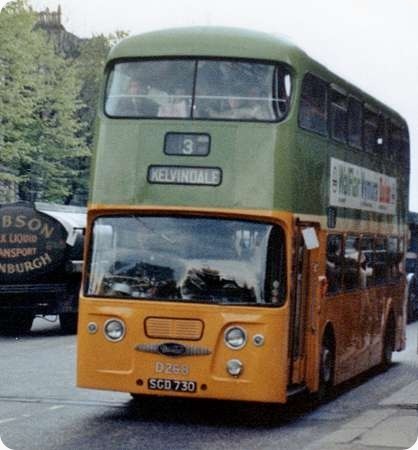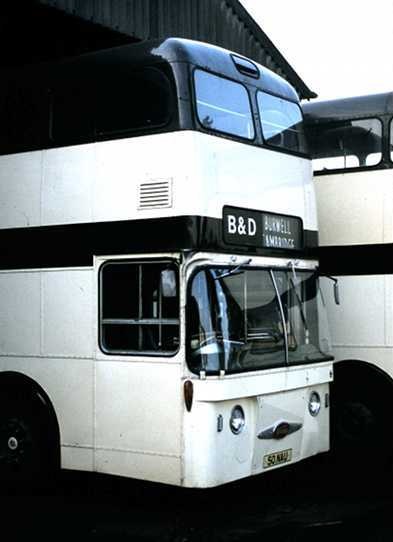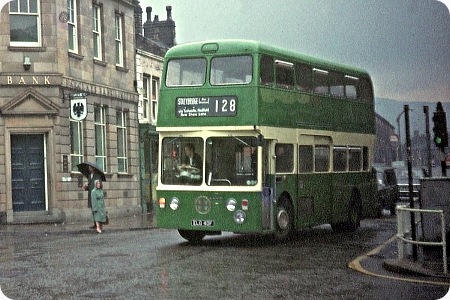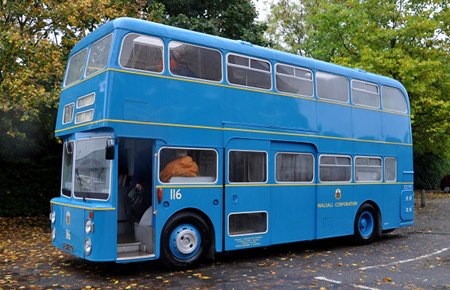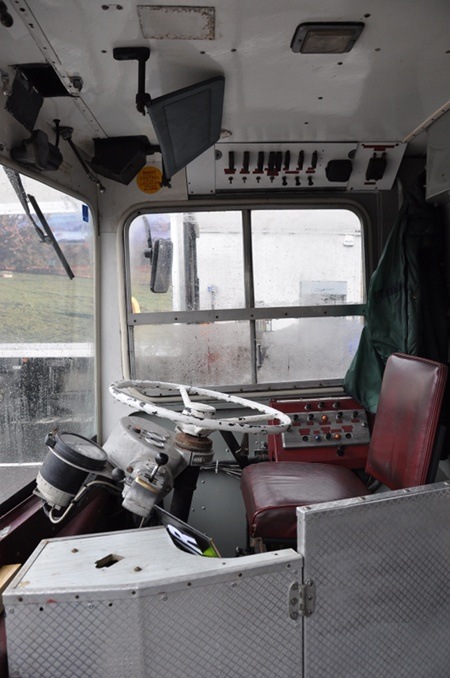Glasgow Corporation – Daimler Fleetline – SGD 730 – D 268
Glasgow Corporation
1963
Daimler Fleetline CRG6LX
Alexander H44/34F
Sorting through my photos recently I came across this shot taken I think in the late sixties in Glasgow. Whilst at a quick glance it looks like any of the Corporations large fleet of Atlanteans. But, a closer look shows it to be D268 their one and only Daimler Fleetline, delivered in 1963 with a body identical to the previously mentioned Atlanteans some of which were delivered with Albion badges. I have a slightly blurred photo of one of these if anyone is interested. Why Glasgow never bought any other Fleetlines in view of the number of CVG,s they had previously bought I do not know, perhaps someone may be able to enlighten me. I vaguely remember taking the photo somewhere near the Botanic Gardens I think, again I am ready to be corrected.
Photograph and Copy contributed by Diesel Dave
09/01/13 – 05:42
I’d heard of Kelvingrove, but Kelvindale is a new destination to me.
Jim Hepburn
09/01/13 – 16:01
Information about Kelvindale can be found at //en.wikipedia.org/. or at //kelvindale.org.uk/
Ken Jones
10/01/13 – 17:50
Looking at this photo now makes me realise the Glasgow Alexander body design was a true classic and probably the most successful of the first generation rear engined body designs. In fact it doesn’t look to dated when set against the modern offerings on the low-floor chassis of today.
Philip Halstead
11/01/13 – 08:06
Somehow, the low height version of the body looked even better and, yes, it wouldn’t look out of place on today’s streets. Other 1960s bodies which would still look up to date would be the Mancunian, especially the 33ft version and the 1968 Park Royal body on Sheffield’s Atlanteans.
Phil Blinkhorn
13/01/13 – 07:37
Phil: I couldn’t agree more about the Mancunian; I was impressed with it from the outset. Although many people deride its squareness, I find it stylish, of its time, and yet timeless. Manchester took the bull by the horns by creating a brand new livery that was totally suited to the body.
Alan Murray-Rust
14/01/13 – 13:17
About Philip H’s comments and the Fleetlines….Have to agree that in design terms, they are probably ‘up there’ with the true classics of their time….I remember the first time I saw a NWRCC example in Mersey Square and standing fixated for what might have been fifteen minutes at just how futuristic they looked compared to everything else around them….But a question to those of you who are far more technical and knowledgeable than myself….Were the windscreens on these Fleetlines the same piece/part/whatever as the those on the NWRCC Alexander bodied PSU3/4R Leopards?? And was the upstairs front windscreen on the Fleetline the same piece/part/whatever as the rear window on the PSU3’s?? I’ve often wondered whether the size/shape of what at the time were fairly huge single pieces of shaped glass just Alexander’s ‘brand design’ or whether it was actually a very clever innovation by them to reduce component/stock requirements in their manufacturing process which just happened to turn out right aesthetically….
Stuart C
14/01/13 – 15:32
Stuart C the answer to both your windscreen questions id yes. Economy sometimes can be translated into a timeless design!!
Phil Blinkhorn
14/01/13 – 15:59
I agree entirely with Philip on the timelessness of this Alexander design. Modern double deck body builders seem to compete with each other to accommodate the greatest area of frontal glass. Replacement costs must be astronomic.
Roger Cox
12/03/13 – 06:33
Stuart, both screens were used on the Alexander Y Type single decker – in fact, the entire GRP moulding of the upper dome was used!
Anon
19/08/13 – 07:20
The bus was based at Maryhill garage from 1964 approx where I was a driver and have driven the Daimler many times on service route 3 which ran from Mosspark to Kelvindale. The Daimler was not first choice of the drivers the doors were operated by way of the gear stick. You had the normal gear change with an additional slot for opening and closing the doors the bus had to be at a halt before you could open or close the doors resulting in late running, hope this helps.
Frank
20/08/13 – 06:32
Truly understand where you are coming from Frank.
When I was driving at Swinton for LUT, we had 2 of the first batch of dual doored Daimler Fleetline 33 footers, nicknamed ‘Jumbo’s. They were fleet nos 360 & 361, ATC 273 & 4 J. Although there was no agreement in place with the TGWU for their use as one-manners, Management was adamant and Supervisory staff were were made to frequently check that they were being used, even in crew operation, as dual door buses, in what they saw/said was their ‘pending’ one man introduction. The problem with them, was the Doors ! The front door was air pedal controlled, but the REAR door was electronic, via a sixth gear position on the selector. The gear selector would not move until the rear doors, which had an electrical sensor, confirmed that they had closed. Well, even on the moderately timed 38 service, where they were allocated, this slow & time consuming operation meant that time was lost at every stop. I tried with my guard one day to use a ticket roll to tape off the centre door on a very busy trip (17:20 hours) out of Manchester one evening, but was caught by a ‘checker’ and reported for not using the centre doors. I think I had the last laugh however, as I found that by pushing the ‘Master switch’ to off, the centre doors closed automatically and the gear selector was released ! – but this trick needed two hands to perform.
Happy Days
Mike Norris
23/09/13 – 06:00
Diesel Dave thanks for your photo of Daimler D268 you are correct the location is at Botanic Gardens at the intersection of Byres Road and the Great Western Road hidden by the tanker to the left of Daimler D268 is the rest room then used by bus staff for meal breaks.
Frank
24/09/13 – 09:28
On the subject of modern classics I would add the Leeds Roe dual door Fleetlines and Atlanteans to the list together with the ECW body for Olympians and VRs. Anyone any thoughts on these or others to add to the list.
Chris Hough
09/01/17 – 06:49
I used to be a regular schoolboy user of the 3 route. I remember how exciting it was when on one morning at the Kelvindale terminus an "Atlantean" turned out to be Fleetline D268. There never seemed to be as many 3s as 20s or 58s on Great Western Road. I recall once literally praying that a 3 would come. And it did, very promptly, except it wasn’t going to Kelvindale, it was a short working to Botanic Gardens. I’ve often wondered how often these short workings occurred, as I can’t definitely recall any others. Possibly Frank, or someone else, might know.
Moray
04/02/17 – 09:30
I worked as a conductor at Parkhead Garage during 1972/73, and vehicles were often "turned short", usually due to late running, crew shortage, or vehicle breakdown (by the time a replacement vehicle was put on the road part of the journey would be "lost"). The timetables only listed the theoretical departures from the termini concerned, although estimated journey times between principal stops were also given. However, these referred to rush hour conditions, and the actual running times were often less than those printed in the timetable book. We had a 4 bus allocation on service 38, where the bulk of the journeys were shared between Gartcraig and Newlands. On several occasions when heading back into the city from either Rouken Glen or Clarkston, we would be stopped by the timekeeper at Shawlands Cross and told to change the destination to show "Alexandra Park" instead of Riddrie or Millerston. Our last stop would be outside the Corporation crew "bothy" at St Rollox bowling green in Alexandra Parade, where we should have been relieved by another crew. However, if any of the crew were not available, we would then be instructed to run to Parkhead Garage. We were expected to run there in service along Edinburgh Road, but the reality was (despite the rule book) that Glasgow Corporation buses only picked up on garage journeys when travelling along the recognised route. As one of the bigger garages we had a few duties where we went out to assist on other services, and we would end up on 41s, 64s, and hospital specials on services 11 and 16 Sundays. There were also scheduled crew duplicates on OMO service 55 at peak hours, where we ran back to Parkhead Garage from Barmulloch, showing service 55 all the way eastwards along Duke Street. Great days for people like myself who liked a bit of variety at work. If we actually managed to get 4 buses out on the 38s all day it was a bonus. In later life I did 11 years as a driver for one of the large companies in a rural area, but it was nothing like the old Corporation.
John W
28/03/19 – 07:19
Two years on from the above, but in 1973-4 I lived right by the Botanic Gardens short turning point, which coming from the city was left into Kersland Street, where there was an alighting stop, then first right into Vinicombe Street, and back up Byers Road and back to town. I recall that some 58s, on Saturdays only, were timetabled to do this, other occasions were random. The side streets were lined with parked cars both sides, but the buses squeezed past any oncoming car.
One evening peak an Atlantean had unloaded, and turned right into Vinicombe Street, only to come nose-to-nose with, of all things, an Alexander (Midland) PD3 coming the other way, doing a short inward working from Great Western Road and turning by the same streets to go back out of town again. This was an unusual working but happened occasionally. Unfortunately I couldn’t hang around to see how they sorted it out.
Bill
14/05/19 – 06:22
Working at Partick Garage 1969 til 1974 I passed my test at Knights Wood Garage when I turned 21. I drove Leyland Atlanteans including LA1 which is now in the museum. My first driving job was in the evening rush hour on an AEC with neither power nor self centring steering. Today’s drivers would struggle with these vehicles. I am now back in my home city of Nottingham.
Melvyn Hill
Quick links to the - Comments Page - Contact Page - Home Page
